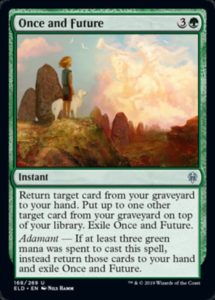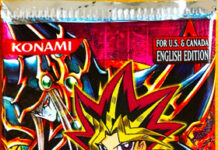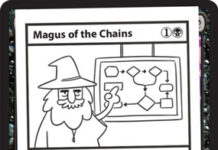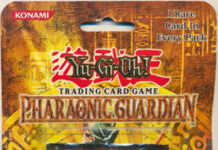I spent years hoping and praying for an Arthurian set or block. There are sidelong references to Arthur as far back as Limited Edition Alpha, but Magic avoided doing a full-scale exploration of the images for most of its history. In part, this has to do with their importance to modern fantasy – there’s a lot of overlap between Arthurian concepts and the “default” style of western fantasy. Evoking them stirs deep feelings in English-speaking audiences and many others besides, and invite us to consider deep questions and difficult choices. After so long, I had thought Magic would never do them, but they did – and then they did them again.
Well, sort of. Wilds of Eldraine is supposed to lean more into the faerie tale side of the titular plane. And for me, it is actually preferable in some ways to the first Eldraine set. One type of comment I saw people posting about Throne of Eldraine was that it reminded them of the darker and grittier retellings of faerie tales – think of something like Zenescope’s Grimm Fairy Tales. Personally, I have no doubt that property was one of the things that convinced Wizards of the Coast to try an official faerie tale set, even if the series is too sexualized for Mark Rosewater to mention to an audience whose average age is 29. But I never liked Grimm Fairy Tales, or things like it. We already know that a lot of our retellings gloss over interpersonal issues and, yes, sex, because these can become a threat to societal hierarchies and structures. We already know that a lot of our retellings also gloss over the violence and hardship of the periods when faerie tales were composed, because we want and hope to move beyond them. We already know that an institution like the Knights of the Round Table is human and thus corruptible, and can become menacing to those who don’t fit easily into its definitions of authority or law. You don’t need to wallow in it, especially when you’re going to draw readers in with incredibly slick and sexualized art that you clearly put three times as much effort into compared to the actual story, a story which says nothing we didn’t already know. Throne of Eldraine is not entirely like Grimm Fairy Tales and it remains one of my favorite sets for flavor. There are, though, a few places where I thought it skirted that line; particularly in flavor text that came across as a little more cynical or gratuitous than it needed to be.
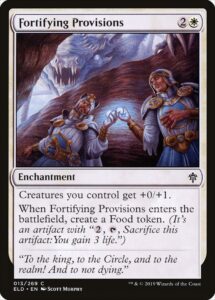
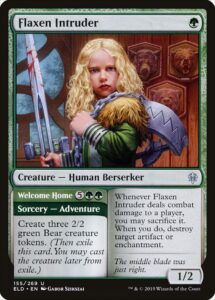
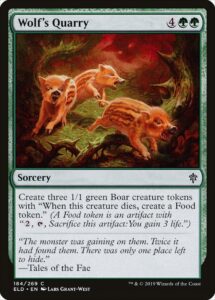
But Wilds of Eldraine gives more prominence to the whimsical and absurd side of faerie tales. Five years ago, if you had told me that the not-too-distant future would have black-bordered, mainline set cards named “Tough Cookie”, “Food Fight”, and “Faerie Slumber Party”, I never would have believed you. This side of faerie tales is equally important because it is also a bedrock of the human condition. I am a university lecturer, and there are a lot of things I enjoy about my job; and, of course, I need it to make a living, and it’s important because of that. I also put on clothes I’d really rather not wear, sit on a train in a crowd of people who don’t seem to see each other, and stand at the front of the classroom and beg the students not to cheat. Everything is absurd, from some perspective. Thus, whimsical and absurd stories remind us not to take things too seriously, or at least not the wrong things. And importantly, they give the serious parts meaning: when everything is edgy, nothing is edgy. Even a story like Red Riding Hood, which is about sex and death and blood and everything you see or don’t see in the shadows, has the slapstick element of “what big eyes you have!”.
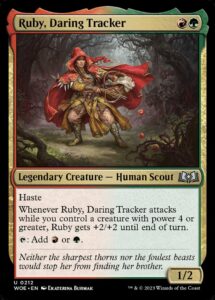
Not only are the faerie tale tropes and the delightful pun names even more prominent than in our last visit, Wizards of the Coast is dabbling in a different style of storytelling than we’ve been used to. In addition to the formal Story Spotlight cards, picking out the right cards from each of the ten two-color pairs tells you a story inspired by a famous faerie tale. Don’t take my word for it – Mark Rosewater wrote a whole article about it. He probably had to, because it’s easy to miss this when you’re looking through random cards from a set booster, but I’m still glad they tried it. This is an early attempt at the concept, and there are bound to be some issues; and something has to take the first step. What better place to do it? No plane lends itself more to this concept than Eldraine (perhaps Theros or Kaldheim . . . or maybe Lorwyn?).
It would have been nice if this could have been more prominent. I opened a Wilds of Eldraine bundle and a set booster box, and didn’t run across any explanation of this storytelling device. There seem to be no helper cards or ads that draw attention to this, and honestly, I’m not sure why. The whole point of Eldraine is the setting and the flavor. Perhaps the designers figured that the evocative nature of the source material would carry it. And some of the individual components do stand out more than others – Ruby’s rescue mission in Sweettooth and Johann burning down the tower are notably hard to miss, but it might have been possible to make more of a cue that we should be looking for the other pieces of the stories. But to reiterate, this idea does have promise, and I wouldn’t be entirely surprised if Murders at Karlov Manor has something similar. (It seems like the most fun way they could fulfill the announcement’s promise of giving players a mystery to solve.)
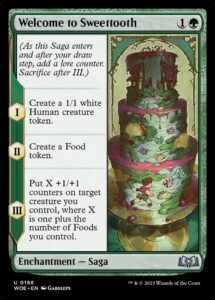
The focus on the faerie tale tropes also has a curious impact on the set’s focus. Why did I describe it as “supposed to” be about those tropes? Because their prominence might have actually made the plane feel more like Arthurian fantasy. The influence of magic and other faerie tale concepts is present – and stronger – in more of the Round Table stories than we sometimes realize. For example, the Green Knight is a character who most likely comes directly out of Celtic folklore, and was adapted for the Christian audiences who read and heard Arthurian tales in the Middle Ages. The same can be said of any story involving Merlin, Morgan le Fay, and the Lady of the Lake. The quest for the Holy Grail is a similarly Christianized variant of the faerie tale trope of travelling into a strange otherworld where normal rules don’t apply. This is why something like the Disney movie The Sword in the Stone fits so well in the canon of the studio’s more explicitly faerie tale-inspired works. And on top of that, Wilds of Eldraine‘s premise, the excuse for focusing on the Wilds and its fae denizens, is adapted from one of the most iconic plot points from the entire mythos: the destruction of the courts by the Phyrexian invasion is the plane’s answer to the fall of Camelot.
I’ve long suspected that the fall of Camelot was a story that arose from the same deep-seated impulse that gave us the story of Ragnarok: the subconscious awareness that entropy always increases over time, and that things you love won’t be around forever. Both of them also have a common thread in the role the leaders play in their own downfall – the question of whether all Odin’s actions to avert Ragnarok actually helped or rather brought it closer, and the fact of Arthur’s downfall at the hands of Mordred, a living symbol of the king’s unsuccessfully buried moral failings. And in both cases, they invite us to ponder what comes after the end.
In the Seeress’ Prophecy, the question is answered very specifically: there will be a new world and a new Asgard, where the gods’ halls stand tall in the sunlight, and mortals have a chance to try again. In Le Morte d’Arthur, the final passages see Bedivere, Lancelot, and Guinevere departing to make amends via religious service, fitting with the medieval context in which it was written. In Wilds of Eldraine, we learn that the plane was bigger than we realized, with even more interesting and stranger denizens than we had a chance to see the first time around. And, like the best faerie tales, this reminds us of something very important about our own lives, in a time when many of us are again wondering whether we will live to witness the end.
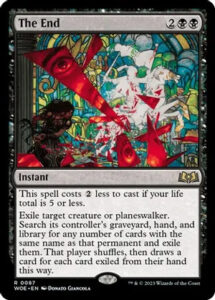
Some people believe that King Arthur and his Round Table were inspired by a real person, or more than one person. I happen to agree with this, because one of the most popular theories involves a circumstantially-documented, extremely plausible pathway. It argues that the historical “Round Table” arose as the Roman authorities withdrew from Britain, leaving behind Romanized locals and former legionnaires who became the leaders of a new societal order. It would have been this order that saw increasing viking-style attacks from Saxons and other tribes originating in what is now Germany; it would have been this order that fought against the larger incursions, and eventually saw migrations on a massive scale. It would have been this order that saw their world – their political and economic realities – come to an end, not once but twice.
But in another sense, their world did not end. Arthur, whoever he really was, was one or more of their leaders, and we still call him the Once and Future King. They are a part of us, and we carry a part of them. This year’s Magic sets are a microcosm of this truth: Wilds of Eldraine is so unlike Throne of Eldraine, but it grew from the soil prepared by that set. The upcoming Lost Caverns of Ixalan has things we never could have imagined when the original block was released, but that original’s spirit runs through it. Arthur is dead, but Arthur is everywhere. We may well live to see the end. But we will also see the beginning.
